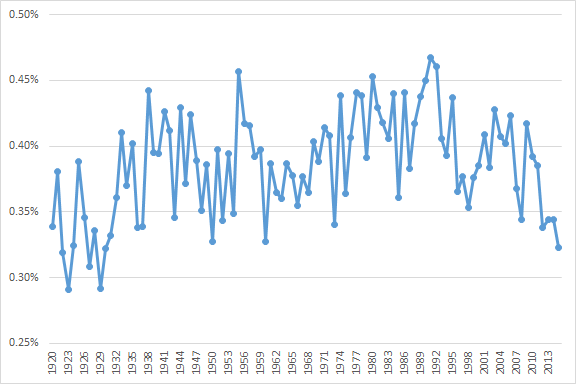After ten weeks, I calculated the pass identities of every team in the NFL. At the time, I noted that it was weird how Denver was the 4th most pass-happy team in the NFL despite, you know, Peyton Manning playing like the worst quarterback in football and the Broncos owning the league’s top defense. Of course, there’s one problem: the Broncos rushing attack is pretty bad, too.
Since then, the Broncos have played three games. The first came against the Bears, who have a terrible rush defense. As a result, Ronnie Hillman and C.J. Anderson rushed 33 times for 161 yards, and the Broncos ran on over half of their plays. The next week, against the Patriots, things changed dramatically after Dont’a Hightower went down:
As masslive.com’s Kevin Duffy noted, the Broncos ran the ball 15 times for a total of just 43 yards with Hightower in the lineup. After Hightower left, Denver ran the ball 17 times for a whopping 136 yards, averaging an even 8 yards per carry. Three of Denver’s four touchdowns came on the ground, including a sweep that produced two long scores from short yardage on second-and-1 and third-and-1.
Denver trailed 21-7 at the start of the 4th quarter, but wound up winning the game, in large part thanks to the rushing attack. Of course, with #QBWinz being what they are, Brock Osweiler received a lot of credit for running his record to 3-0. Then, the Raiders game happened.
Denver dominated the Raiders in the first half, as Oakland gained negative 12 yards — that’s NEGATIVE TWELVE YARDS — in the first 30 minutes. But the Broncos only led 12-0, in part because of the team’s struggles on the ground. Hillman and Juwan Thompson finished the game with 17 carries for just 28 yards. Meanwhile, Osweiler recorded 56 pass attempts! In some ways, it is incomprehensible that a team could have a positive Game Script, a 12-0 half time lead, and yet put the ball in the hands of its first-year starting, below-average quarterback 39 more times than in the hands of all of your running backs combined. But when your running backs are averaging 1.6 yards per carry, there may not be much of an alternative.
Osweiler struggled, of course, finishing with 4.92 ANY/A on his 56 pass attempts, and also taking a safety, while Denver went just 4-18 on third downs. The Broncos passed a ton under Manning despite Manning struggling all season; now, with the running game ineffective, the same thing is happening under Osweiler (to be fair, there were a number of drops by the Broncos receivers, making this more of a passing game issue than a pure quarterback issue). The Broncos defense is awesome, but the team may not be able to get very far if the offense is throwing on 70%+ of its plays. Anderson missed the Raiders game with an ankle injury, and while he hasn’t been the star back he was at the end of last year, the Broncos offense sorely needs a healthy Anderson.
Below are the week 14 Game Scripts data:
[continue reading…]






